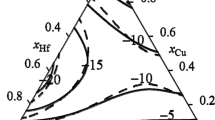Abstract
Results of an experimental study of the interaction between corium melts of various compositions in the UO2 — ZrO2 — Fe(Cr, Ni)Oi system and the hard ZrO2 wall of a cold crucible upon induction heating are presented. The conditions of heating, melting, and interaction with the hard wall and the heat balance in such a crucible are considered with allowance for the special features of the behavior of two-phase melts, when the melting occurs at a temperature ranging from liquidus to solidus. The notion of the effective liquidus temperature below which the binary system behaves as a solid body and above which it behaves as a liquid is suggested. The results of the analysis show that an unknown high-temperature (Tmelt ≈ 2700 K) compound of composition close to 5UO2 · 7ZrO2 · 4Fe(Cr, Ni)Oi exists in the UO2 — ZrO, — Fe(Cr, Ni)Oi system.
Similar content being viewed by others
References
S. V. Beshta, V. B. Khabenskii, and E. V. Krushinov, “A study of the interaction between molten UO2+ x-ZrO2-Fe(Cr, Ni)Oy, and ZrO2Vbaseconcrete,”Ogneup. Tekh. Keram.,No.1, 28 — 32 (2000).
E. P. Pakhomov, A. I. Romanov, L. G. Smirnova, et al., “Testing linings from TsGB concrete in a high-temperature flow of combustion products,”Ogneupoiy, No. 5, 6–9 (1990).
T. I. Borodina, G. E. Val’yano, N. G. Dolgireva, and E. P. Pakhomov, “Formation of zonal structure in a zirconia-base lining,”Ogneupory, No. 6, 22 — 27 (1990).
O. V. Bakunov, L. B. Borovkova, T. A. Melekhina, et al., “A study of high-temperature tensile strength of zirconia hydration-hardening concrete,”Ogneupory, No. 7, 11 — 19 (1990).
O. V. Bakunov, L. B. Borovkova, T. A. Melekhina, E. P. Pakhomov, et al., “A comparative study of high-temperature tensile strength of zirconia-base concretes,”Ogneupory, No. 8, 16–19(1990).
A. A. Akopyan, B. M. Barykin, Yu. D. Novov, and E. P. Pakhomov, “Thermo and electrophysical characteristics of a zirconia-base concrete on hydration binder,”Ogneupory, No. 8, 19–22(1990).
L. B. Borovkova, T. I. Borodina, G. E. Val’yano, et al., “Improvement of the composition and study of the characteristics of a modified hydration-hardening zirconia concrete for high-temperature lining,”Ogneupory, No. 3, 8 — 13 (1991).
O. V. Bakunov, L. B. Borovkova, T. I. Borodina, et al., “A study of the tensile strength of hydration-hardening zirconia concrete in the range 300 — 2300 K,”Ogneupory, No. 5, 4 — 8 (1991).
E. P. Pakhomov and L. P. Krishchenko, “A model of the interaction between corium oxide melt and a ZrO2 trap,”Ogneup. Tekh. Keram., No. 3, 13 — 18 (1997).
N. A. Toropov, V. P. Barzakovskii, V. V. Lapin, and N. N. Kurtseva,Phase Diagrams of Silicon Systems. A Handbook. Issue 1. Binary Systems. Vol. 1 [in Russian], Nauka, Leningrad (1969).
Author information
Authors and Affiliations
Additional information
Translated from Ogneupory i Tekhnicheskaya Keramika, No. 3, pp. 11–22, March, 2000.
Rights and permissions
About this article
Cite this article
Pakhomov, E.P. Determination of the liquidus surface in the UO2 — ZrO2 — Fe(Cr, Ni)Oi system. Refract Ind Ceram 41, 84–95 (2000). https://doi.org/10.1007/BF02693833
Issue Date:
DOI: https://doi.org/10.1007/BF02693833




